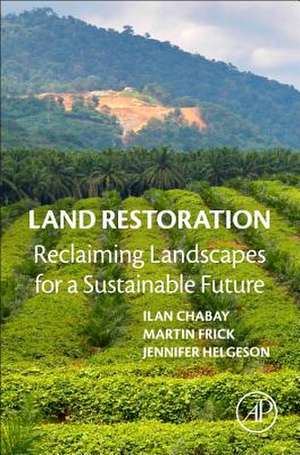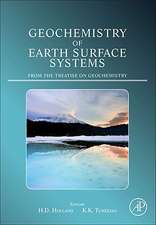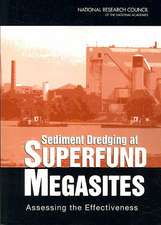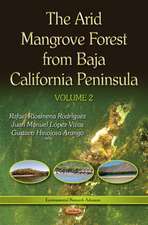Land Restoration: Reclaiming Landscapes for a Sustainable Future
Editat de Ilan Chabay, Martin Frick, Jennifer Helgesonen Limba Engleză Hardback – 26 noi 2015
Land Restoration: Reclaiming Landscapes for a Sustainable Future brings together practitioners from NGOs, academia, governments, and the United Nations Convention to Combat Desertification (UNCCD) to exchange lessons to enrich the academic understanding of these issues and the solution sets available.
- Provides accessible information about the science behind land degradation and restoration for those who do not directly engage with the science allowing full access to the issue at hand.
- Includes practical on-the-ground examples garnered from diverse areas, such as the Sahel, Southeast Asia, and the U.S.A.
- Provides practical tools for designing and implementing restoration/re-greening processes.
Preț: 533.47 lei
Preț vechi: 685.06 lei
-22% Nou
Puncte Express: 800
Preț estimativ în valută:
102.08€ • 109.16$ • 85.11£
102.08€ • 109.16$ • 85.11£
Carte tipărită la comandă
Livrare economică 10-24 aprilie
Preluare comenzi: 021 569.72.76
Specificații
ISBN-13: 9780128012314
ISBN-10: 0128012315
Pagini: 598
Ilustrații: Illustrated
Dimensiuni: 191 x 235 x 33 mm
Greutate: 1.38 kg
Editura: ELSEVIER SCIENCE
ISBN-10: 0128012315
Pagini: 598
Ilustrații: Illustrated
Dimensiuni: 191 x 235 x 33 mm
Greutate: 1.38 kg
Editura: ELSEVIER SCIENCE
Cuprins
Foreword
Governing Land Restoration: Four Hypotheses
Introduction
Part 1 Social contexts of land restoration
Chapter 1.1 Land Degradation as a Security Threat Amplifier: The New Global Frontline
Chapter 1.2 Land Degradation and Its Impact on Security
Chapter 1.3 (Em)Powering People: Reconciling Energy Security and Land-Use Management in the Sudano-Sahelian Region
Chapter 1.4 Enabling Governance for Sustainable Land Management
Part 2 Concepts and Methodologies for restoration and maintenance
Chapter 2.1 Tenets of Soil and Landscape Restoration
Chapter 2.2 Stabilization of Sand Dunes: Do Ecology and Public Perception Go Hand in Hand?
Chapter 2.3 Trust Building and Mobile Pastoralism in Africa
Chapter 2.4 Land Degradation from Military Toxins: Public Health Considerations and Possible Solution Paths
Chapter 2.5 Flood and Drought Prevention and Disaster Mitigation: Combating Land Degradation with an Integrated Natural Systems Strategy
Chapter 2.6 Environmental Security, Land Restoration, and the Military: A Case Study of the Ecological Task Forces in India
Chapter 2.7 Releasing the Underground Forest
Part 3 Soil, Water, and Energy – The Relationship to Land Restoration
Chapter 3.1 Computational Policy Support Systems for Understanding Land Degradation Effects on Water and Food Security for and from Africa
Chapter 3.2 The Value of Land Restoration as a Response to Climate Change
Part 4 Economics, Policy, and Governance of Land Restoration
Chapter 4.1 The Importance of Land Restoration for Achieving a Land Degradation-Neutral World Chapter 4.2 Transforming Land Conflicts into Sustainable Development: A Case of the Taita Taveta of Kenya
Chapter 4.3 Case Study: Taranaki Farm Regenerative Agriculture. Pathways to Integrated Ecological Farming
Chapter 4.4 Regenerating Agriculture to Sustain Civilization
Chapter 4.5 Land Degradation: An Economic Perspective
Chapter 4.6 Four Returns, Three Zones, 20 years: A Systemic Approach to Scale Up Landscape Restoration by Business and Investors to Create a Restoration Industry
Chapter 4.7 Restoring Degraded Ecosystems by Unlocking Organic Market Potential: Case Study from Mashonaland East, Zimbabwe
Chapter 4.8 A Continuing Inquiry into Ecosystem Restoration: Examples from China’s Loess Plateau and Locations Worldwide and Their Emerging Implications
Part 5 The Community as a Resource for Land Restoration
Chapter 5.1 Poverties and Wealth: Perceptions, Empowerment, and Agency in Sustainable Land Management
Chapter 5.2 All Voices Heard: A Conflict Prevention Approach to Land and Natural Resources
Part 6 Gender in the Context of Land Restoration
Chapter 6.1 Land Restoration, Agriculture, and Climate Change: Enriching Gender Programming Through Strengthening Intersectional Perspectives
Chapter 6.2 Gender Roles and Land Use Preferences – Implications to Landscape Restoration in Southeast Asia
Part 7 Communities, Restoration, and Resilience
Chapter 7.1 Drought-Management Policies and Preparedness Plans: Changing the Paradigm from Crisis to Risk Management
Chapter 7.2 Not the Usual Suspects: Environmental Impacts of Migration in Ghana’s Forest-Savanna Transition Zone
Chapter 7.3 The Global Restoration Initiative
Part 8 Selected Case Studies
Chapter 8.1 Indigenuity: Reclaiming Our Relationship with the Land
Chapter 8.2 Land Restoration and Community Trust: Keys to Combating Poverty
Chapter 8.3 Shifting from Individual to Collective Action: Living Land’s Experience in the Baviaanskloof, South Africa
Chapter 8.4 Development and Success, For Whom and Where: The Central Anatolian Case
Chapter 8.5 Sharing Knowledge to Spread Sustainable Land Management (SLM)
Part 9 Suggestions for Ways to Use this Book
Chapter 9.1 Buffets, Cafes, or a Multicourse Meal: On the Many Possible Ways to Use this Book
Part 10 Concluding Remarks and a Way Forward
Chapter 10.1 Concluding Remarks
Governing Land Restoration: Four Hypotheses
Introduction
Part 1 Social contexts of land restoration
Chapter 1.1 Land Degradation as a Security Threat Amplifier: The New Global Frontline
Chapter 1.2 Land Degradation and Its Impact on Security
Chapter 1.3 (Em)Powering People: Reconciling Energy Security and Land-Use Management in the Sudano-Sahelian Region
Chapter 1.4 Enabling Governance for Sustainable Land Management
Part 2 Concepts and Methodologies for restoration and maintenance
Chapter 2.1 Tenets of Soil and Landscape Restoration
Chapter 2.2 Stabilization of Sand Dunes: Do Ecology and Public Perception Go Hand in Hand?
Chapter 2.3 Trust Building and Mobile Pastoralism in Africa
Chapter 2.4 Land Degradation from Military Toxins: Public Health Considerations and Possible Solution Paths
Chapter 2.5 Flood and Drought Prevention and Disaster Mitigation: Combating Land Degradation with an Integrated Natural Systems Strategy
Chapter 2.6 Environmental Security, Land Restoration, and the Military: A Case Study of the Ecological Task Forces in India
Chapter 2.7 Releasing the Underground Forest
Part 3 Soil, Water, and Energy – The Relationship to Land Restoration
Chapter 3.1 Computational Policy Support Systems for Understanding Land Degradation Effects on Water and Food Security for and from Africa
Chapter 3.2 The Value of Land Restoration as a Response to Climate Change
Part 4 Economics, Policy, and Governance of Land Restoration
Chapter 4.1 The Importance of Land Restoration for Achieving a Land Degradation-Neutral World Chapter 4.2 Transforming Land Conflicts into Sustainable Development: A Case of the Taita Taveta of Kenya
Chapter 4.3 Case Study: Taranaki Farm Regenerative Agriculture. Pathways to Integrated Ecological Farming
Chapter 4.4 Regenerating Agriculture to Sustain Civilization
Chapter 4.5 Land Degradation: An Economic Perspective
Chapter 4.6 Four Returns, Three Zones, 20 years: A Systemic Approach to Scale Up Landscape Restoration by Business and Investors to Create a Restoration Industry
Chapter 4.7 Restoring Degraded Ecosystems by Unlocking Organic Market Potential: Case Study from Mashonaland East, Zimbabwe
Chapter 4.8 A Continuing Inquiry into Ecosystem Restoration: Examples from China’s Loess Plateau and Locations Worldwide and Their Emerging Implications
Part 5 The Community as a Resource for Land Restoration
Chapter 5.1 Poverties and Wealth: Perceptions, Empowerment, and Agency in Sustainable Land Management
Chapter 5.2 All Voices Heard: A Conflict Prevention Approach to Land and Natural Resources
Part 6 Gender in the Context of Land Restoration
Chapter 6.1 Land Restoration, Agriculture, and Climate Change: Enriching Gender Programming Through Strengthening Intersectional Perspectives
Chapter 6.2 Gender Roles and Land Use Preferences – Implications to Landscape Restoration in Southeast Asia
Part 7 Communities, Restoration, and Resilience
Chapter 7.1 Drought-Management Policies and Preparedness Plans: Changing the Paradigm from Crisis to Risk Management
Chapter 7.2 Not the Usual Suspects: Environmental Impacts of Migration in Ghana’s Forest-Savanna Transition Zone
Chapter 7.3 The Global Restoration Initiative
Part 8 Selected Case Studies
Chapter 8.1 Indigenuity: Reclaiming Our Relationship with the Land
Chapter 8.2 Land Restoration and Community Trust: Keys to Combating Poverty
Chapter 8.3 Shifting from Individual to Collective Action: Living Land’s Experience in the Baviaanskloof, South Africa
Chapter 8.4 Development and Success, For Whom and Where: The Central Anatolian Case
Chapter 8.5 Sharing Knowledge to Spread Sustainable Land Management (SLM)
Part 9 Suggestions for Ways to Use this Book
Chapter 9.1 Buffets, Cafes, or a Multicourse Meal: On the Many Possible Ways to Use this Book
Part 10 Concluding Remarks and a Way Forward
Chapter 10.1 Concluding Remarks









